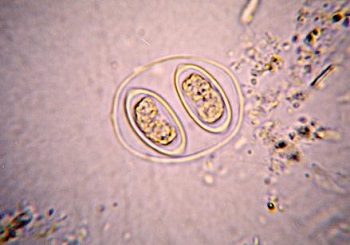Cyclospora cayetanensis - Epidemiology, Reservoir, Transmission, Laboratory Diagnosis, Treatment, Prevention, Control
Epidemiology of Cyclospora cayetanensis
Epidemiologically, Cyclosporiasis is endemic to Nepal, Peru, and Haiti with cases showing seasonal predominance in rainy or summer months. Also, cases of Cyclospora cayetanensis infection have been reported in travelling returning from countries such as Mexico, Morocco, Indonesia, and Puerto Rico.
Reservoir, Source, Transmission of Cyclospora cayetanensis
As sporulating Cyclospora cayetanensis oocysts are infective, contaminated water, fruits and vegetables which are eaten raw are a source of infection.
Transmission occurs through the faecal-oral route.
Laboratory Diagnosis of Cyclospora cayetanensis
Identification and demonstration of Cyclospora cayetanensis oocysts in the specimen is done for diagnosis of infection.
Sample
stool
Microscopy
Cyclospora cayetanensis oocysts are 8μm to 10μm which is twice the size of Cryptosporidium
Microscopic examination of the specimen after direct wet mount preparation and acid-fast staining methods (Ziehl-Neelson or Kinyoun acid-fast stains) is done to determine the presence/absence of oocysts.
Since oocysts are excreted variably in the stool and are variable acid-fast, multiple stool samples (2-3 stool samples in 2 days to 3 days intervals) should be examined.
In a positive stool smear, around 50% of oocysts are acid-fast (pink-coloured) while the rest are non-acid-fast (colourless)
Lacto-phenol cotton blue (LPCB) wet mount of direct stool smear is used to detect blue-stained Cyclospora cayetanensis oocysts
Also, the concentration of stool by methods such as formalin-ethyl acetate sedimentation and Sheather’s sucrose concentration can be used to concentrate the oocysts before microscopic examination.

Image: C. cayetanensis oocyst (Source: Springer Link)
Serodiagnosis
No serological methods are available to detect Cyclospora cayetanensis oocysts in the sample.
Molecular methods
Molecular methods to detect Cyclospora cayetanensis oocysts in the sample are under development.
A PCR assay which targets small-subunit ribosomal RNA is used for diagnosis. As a false positive is seen with Eimeria spp, the sensitivity is at 62%.
Treatment of Cyclospora cayetanensis
Treatment of Cyclospora cayetanensis are done by:
In immunocompetent hosts, the infection is self-limiting and may require supportive treatment to prevent dehydration
for immunocompromised hosts, trimethoprim-sulfamethoxazole (TMP-SMZ) is used to treat cyclosporiasis and supportive treatment with the replacement of fluid, electrolytes, and nutrients is done
the therapy reduces the excretion of oocysts in stool from 9 days to 1.3 days and stops diarrhoea within 2 days
Prevention, Control of Cyclospora cayetanensis
Prevention, Control of Cyclospora cayetanensis are done by:
Individual prophylaxis
Individual prophylaxis of Cyclospora cayetanensis are done by
improved personal hygiene such as proper washing of hands with soap after defecation and before eating food
treatment of water before drinking such as boiling, filtering the water used in a 0.22-micrometre membrane, iodination with tetracycline hydro per iodide
drinking bottled water while travelling to areas endemic to cyclosporiasis as chlorine treatment cannot kill the cysts
if salad is to be consumed, treat the vegetables with acetic acid or vinegar for 15 minutes
not performing sexual acts that involve faecal-oral contact
Community prophylaxis
Community prophylaxis of Cyclospora cayetanensis is done by
improvement of the water management system to avoid faecal contamination
improvement of sanitation by installing latrines for proper disposal of human faeces